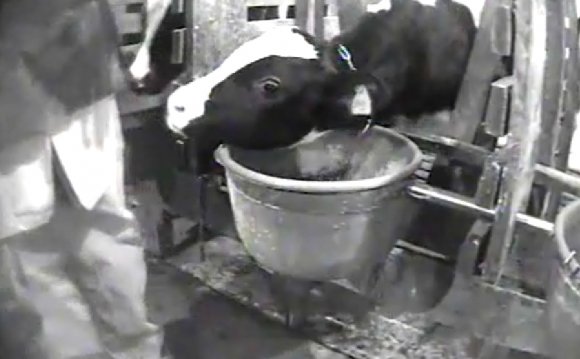
- In nature, pigs live in social groups, often sleeping huddled together.
- Pigs can recognize and remember up to 30 other pigs, and greet each other by making nose-to-nose contact and/or by grooming the other.
- Pigs are capable of learning complex tasks, perceiving time, and anticipating future events.
- Sows spend approximately 31% of their time grazing, 21% rooting, 14% walking, and 6% lying down.
- When given space, sows will seek places apart from nesting and feeding areas to urinate and defecate.
- When released from confinement to semi-natural enclosures, sows quickly revert to natural behaviors like rooting, nest-building, and traveling long distances.
- A pregnant sow may walk up to six miles before finding a sufficiently protected area to build her nest, and can take up to ten hours to complete her nest.
- Pig snouts are highly sensitive tools that help them find a wide variety of foods such as fruits, roots, mushrooms, grasses, earthworms, snakes, and rodents.
- Water is the most important part of a pig’s diet, as a pig’s body is one-half to two-thirds water.
- Some researchers claim that pigs make more than 20 different sounds. Other than the common “oink, oink” sound pigs make, their language also includes jaw chomping, teeth clacking, grunts, roars, squeals, snarls, and snorts.
- Male pigs, called boars, use mating songs when attracting females.
- Female pigs, called sows, use a special grunt to tell their piglets it is time to suckle.
- Baby pigs, called piglets, use a distress call when separated from their mother.
Life of a Pig on a Factory Farm
Approximately 100 million pigs are raised and slaughtered in the U.S. every year. As babies, they are subjected to painful mutilations without anesthesia or pain relievers: Notches are taken out of the piglets’ ears for identification, and their tails are cut off to minimize tail biting, a behavior that occurs when pigs are kept in deprived factory farm environments.
By two to three weeks of age, 15% of the piglets will have died. Those who survive are taken away from their mothers and crowded into metal-barred and concrete-floored pens in giant warehouses. Pigs live in these pens until they reach a slaughter weight of 250 pounds, usually at 6 months of age.
In the U.S. Pork Industry, more than 6 million pigs are used each year for breeding. Breeding sows are treated like piglet-making machines, living a continuous cycle of impregnation and birth, each sow being forced to produce more than 20 piglets a year. During their pregnancies, sows are kept in two-foot wide gestation crates, intended to allow pigs only enough movement necessary to stand up and lie down. Click here to learn more about the future of gestation crates.
At the end of their four-month pregnancies, the sows are moved into farrowing crates, where they spend about a month until their piglets are weaned. After the sows nurse their young for two to three weeks, the piglets are taken away to be fattened, and the sows are re-impregnated and returned to the gestation crates. This cycle continues for the pig’s entire life, about 3 to five years.
On the Farm
The type of housing system used throughout the U.S. to encourage this continuous grueling cycle of breeding sows is gestation crate to farrowing crate to gestation crate. It was developed to allow for economically efficient pork production, requiring less labor and feed than other housing arrangements.
Researchers have found outdoor, crate-free systems and loose housing systems are better for sow health and longevity. In typical U.S. factory farms, however, 100 or more sows per warehouse are kept in gestation crates placed side by side in rows of often more than 20 sows.
Alternative housing exists. An Iowa State University study found significantly lower culling and mortality rates for sows in hoop barns compared to confined sows. Commercial operations also have recorded better reproductive performance and lower mortality rates for sows in pens rather than crates. Currently used alternatives to gestation-crate housing systems include “turn-around” stalls, free-range systems, and indoor group housing.
- Turn-around stalls can be slightly larger than customary gestation crates or have a moving wall that allows the sow to turn around inside the crate.
- Free-range systems afford sows access to the outdoors and, optimally, give pigs the freedom and materials to express natural behaviors like nest-building and rooting.
- Indoor group housing systems house pigs in groups of up to several dozen sows in indoor pens, giving them freedom to move and the opportunity to socialize. Group-housed sows can be fed through automated or manual distribution of enough food for the entire group onto the ground. Some stalls are fitted with a back gate or an automated, controlled rate feeder to eliminate competition for food. The electronic sow feeder (ESF) system allows entry of one sow at a time, identifies her through an electronic tag or collar, and distributes the appropriate ration. When the sow finishes eating, she leaves through a separate exit and the next sow may enter.
This overcrowding and confinement is unnatural since pigs are actually very clean animals. If they are given sufficient space, pigs are careful not to soil the areas where they sleep or eat. But in factory farms, they are forced to live in unsanitary conditions – in their own feces, urine, vomit and the corpses of other pigs.
Physical/Behavioral Effects
Scientific evidence suggests that intensive confinement causes physical disorders in sows. Unnatural flooring and lack of exercise leads to obesity and crippling leg disorders. Further, the air in pig factories is laden with dust, dander, and noxious gases, which are produced as the pigs urine and feces builds up inside the warehouses, causing respiratory difficulties and the spreading of infectious diseases amongst the pigs.
Psychological Effects
Scientific evidence also suggests that intensive confinement causes psychological disorders in sows. The lack of environmental stimulation in the stall environment and the sows’ inability to perform normal behaviors including rooting, foraging, nest-building, grazing, wallowing, or practicing social behaviors, leads to psychological disorders including chronic stress, depression, aggression, and abnormal and neurotic coping behaviors, such as bar biting and sham chewing (chewing nothing).
RELATED VIDEO












